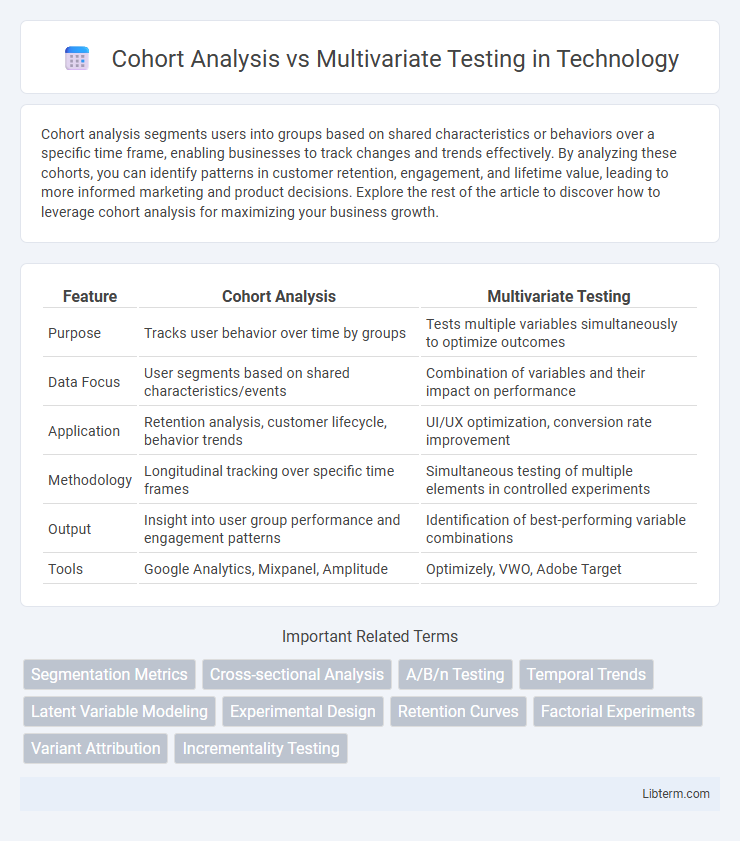Cohort analysis segments users into groups based on shared characteristics or behaviors over a specific time frame, enabling businesses to track changes and trends effectively. By analyzing these cohorts, you can identify patterns in customer retention, engagement, and lifetime value, leading to more informed marketing and product decisions. Explore the rest of the article to discover how to leverage cohort analysis for maximizing your business growth.
Table of Comparison
| Feature | Cohort Analysis | Multivariate Testing |
|---|---|---|
| Purpose | Tracks user behavior over time by groups | Tests multiple variables simultaneously to optimize outcomes |
| Data Focus | User segments based on shared characteristics/events | Combination of variables and their impact on performance |
| Application | Retention analysis, customer lifecycle, behavior trends | UI/UX optimization, conversion rate improvement |
| Methodology | Longitudinal tracking over specific time frames | Simultaneous testing of multiple elements in controlled experiments |
| Output | Insight into user group performance and engagement patterns | Identification of best-performing variable combinations |
| Tools | Google Analytics, Mixpanel, Amplitude | Optimizely, VWO, Adobe Target |
Understanding Cohort Analysis
Cohort analysis segments users into groups based on shared characteristics or behaviors over a specific time frame, allowing businesses to track retention, engagement, and conversion trends within each cohort. By isolating variables related to user experience and lifecycle stages, cohort analysis provides granular insights into how different factors influence customer behavior distinctively from one-time experiments. This method emphasizes long-term performance metrics and behavioral patterns, making it essential for optimizing marketing strategies and product development through continuous, data-driven iteration.
What is Multivariate Testing?
Multivariate testing is a method used to analyze the impact of multiple variables simultaneously on a specific outcome, allowing marketers to determine which combination of elements performs best. By testing different variations of web pages, advertisements, or emails, it identifies the most effective factors influencing user behavior, such as click-through rates or conversions. This approach provides data-driven insights to optimize marketing strategies and improve overall campaign effectiveness.
Key Differences Between Cohort Analysis and Multivariate Testing
Cohort analysis segments users based on shared characteristics or behaviors over a specific period, allowing businesses to track retention, engagement, and lifetime value within distinct groups. In contrast, multivariate testing simultaneously evaluates multiple variables to determine the optimal combination of elements that impact user behavior or conversion rates on digital platforms. While cohort analysis provides insights into longitudinal user trends and patterns, multivariate testing focuses on experimental optimization of interface components for immediate performance improvement.
When to Use Cohort Analysis
Cohort analysis is essential when tracking user behavior over time within specific groups defined by common characteristics, such as signup date or acquisition channel, to identify patterns and trends. It provides insights into retention, lifetime value, and the impact of product changes on defined segments, making it ideal for long-term behavioral analysis. Use cohort analysis when the goal is to understand how changes affect distinct user groups across multiple time periods rather than isolating single variable effects.
Ideal Scenarios for Multivariate Testing
Multivariate testing is ideal for scenarios where multiple variables or page elements need simultaneous evaluation to determine their combined impact on user behavior and conversion rates. This method excels in optimizing complex user interfaces and marketing campaigns by identifying the best-performing combinations of headlines, images, call-to-actions, and layouts. Businesses aiming to enhance user experience and maximize ROI through detailed interaction analysis benefit most from multivariate testing.
Benefits of Cohort Analysis
Cohort analysis enables businesses to track user behavior and performance over specific time periods, providing valuable insights into customer retention and lifecycle trends that multivariate testing alone cannot offer. This method helps identify distinct patterns within user groups, optimizing marketing strategies and product development for sustained growth. By focusing on cohort data, companies can make data-driven decisions that improve customer engagement and increase long-term revenue.
Advantages of Multivariate Testing
Multivariate testing offers the advantage of evaluating multiple variables simultaneously to determine their combined impact on user behavior, enabling more precise optimization of web pages or marketing campaigns. This comprehensive analysis accelerates decision-making by revealing interactions between elements that single-variable tests may overlook. By identifying the best-performing combination of factors, multivariate testing improves conversion rates and user experience more effectively than cohort analysis, which primarily tracks behavior changes over time within specific groups.
Common Tools for Cohort Analysis and Multivariate Testing
Common tools for cohort analysis include Mixpanel, Amplitude, and Google Analytics, which enable businesses to segment users based on behavior over time and track retention and engagement metrics effectively. For multivariate testing, popular platforms such as Optimizely, VWO, and Adobe Target facilitate the simultaneous testing of multiple variables to optimize user experience and conversion rates. Both tool types provide robust analytics and reporting features, but cohort analysis excels in longitudinal user insights, while multivariate testing focuses on real-time optimization of specific elements.
Challenges and Limitations
Cohort analysis faces challenges in isolating variables due to its reliance on grouping users by shared characteristics, which can lead to confounding factors and slower insight generation. Multivariate testing encounters limitations such as increased complexity in test design, higher sample size requirements, and difficulties interpreting interaction effects among multiple variables. Both methods demand extensive data quality and rigorous statistical validation to ensure accurate and actionable results.
Deciding the Best Approach for Data-Driven Insights
Cohort analysis segments users based on shared characteristics or behaviors over time, enabling precise tracking of patterns and user retention, which is essential for lifecycle optimization. Multivariate testing evaluates multiple variables simultaneously to identify the most effective combination of elements in marketing or product design, providing actionable insights for immediate improvements. Choosing between cohort analysis and multivariate testing depends on whether the objective is understanding long-term user behavior or optimizing specific factors for short-term performance gains.
Cohort Analysis Infographic

 libterm.com
libterm.com